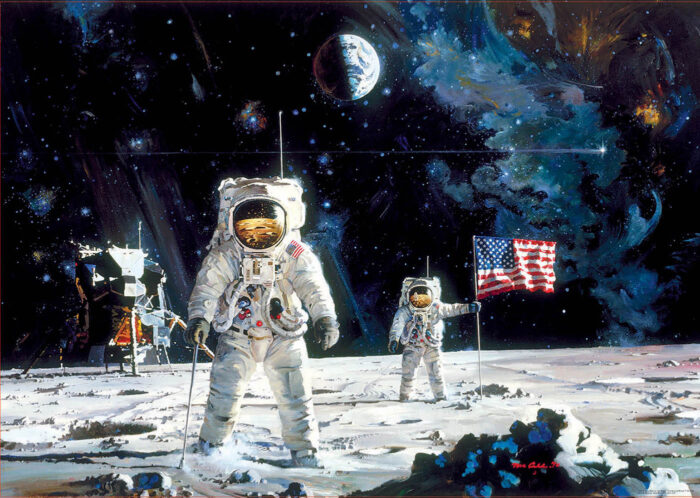

“We choose to go to the moon in this decade,” promised President John F Kennedy a few months after Glenn’s orbit. It took the Apollo programme to show us the true solitary splendour of our life-filled world. In 1962, this was the most remote view of Earth anyone could get: a blue planet, but seen only in part, from close orbit. As he completed his historic orbit in February 1962, he took gorgeous images of the blue sphere, its bright expanse dappled with white vapour, standing out amid the blackness. In fact, the Minolta was loaded with infrared film and used for astronomical images, while Glenn was instead given a Leica to shoot colour photos of Earth way below him. Nasa engineers added a handle to make it easier to hold in his bulky mittens. He bought this new toy, reasoning that automatic focus would save time taking pictures in space. Then he saw, in the Cocoa Beach shop he had popped into after getting a haircut, a Minolta automatic camera.

He wanted to take pictures, but how could he do that while flying Friendship 7, as his craft was called?Īldrin poses next to the stars and stripes. Glenn, one of Nasa’s original team of seven astronauts selected from the test pilot elite, was getting ready for America’s first attempt to put a human in orbit. It all started when John Glenn walked into a store in Cocoa Beach, Florida, at the start of the 1960s. This was the dreamlike climax of a love affair between Nasa’s astronauts and photography – a passion that altered human consciousness for ever. It was, after all, no casual afterthought that Armstrong was standing there in the airless lunar day with a camera in his heavily gloved hands. How, they ask, could this have been possible? But, instead of wasting our time on that, we should ask how Apollo 11 added artistic genius to all its other achievements. The photographs that the pair took during their 21 hours and 36 minutes on Earth’s satellite from 20 to 21 July 1969 are so astonishingly good that their very quality has, perversely, become one of the arguments used by conspiracy theorists who believe the landings were faked. It’s as if the moon’s surface has overwhelmed Aldrin’s face, or even become it. It is a portrait of humanity evolving before our eyes into something new and extraordinary. (His suit is genderless: the Apollo astronauts wore spacesuits made by the bra company Playtex, and their urine-proof underwear was adapted from a girdle.) In losing his selfhood, Aldrin becomes each one of us. Photograph: AFP/GettyĪldrin has become everyman – and everywoman. ‘A thrilling swirl of land, water and cloud’ … Earthrise by Apollo 8’s William Anders. The photographer has incorporated the making of the image into the image, to tell the story of something new in the universe: two human beings looking at each other across the dusty surface of an alien world. Meanwhile, reflected and warped by the helmet, the other horizon stretches away behind Armstrong. Behind Aldrin, the moon’s bright surface recedes to a blue horizon against the black void of space. Yet these reflective qualities are part of what makes this such a powerful, complex image, one in which we can see two lunar horizons. This effacement of Aldrin came about because Apollo astronauts wore visors lined with gold to protect their eyes from sunlight.

His features and flesh are hidden inside a thickly padded white spacesuit, its visor reflecting the tiny figure of Armstrong himself, beside the gold-coloured legs of the lunar lander. His name was Neil Armstrong and his astonishing act of creativity is a photograph of his Apollo 11 crewmate Buzz Aldrin standing on the Sea of Tranquillity on the moon. I did get excited when Apollo 11 landed in 1969 and I could honestly say there was a man ON the moon.F ifty years ago this week, a former navy pilot created one of the most revolutionary artistic masterpieces of the 20th century, one we have yet to fully assimilate. I think I was seeing all of those jagged ridges and dark patches as something else entirely.
#FIRST MAN ON THE MOON PICTURES FULL#
My mom would take me out to the backyard on full moon nights and try to point out the eyes and nose and mouth, but I just couldn't make it into a face. I remember when I was a kid, I felt like I was the only one who couldn't see the "man in the moon". There's just something comforting about knowing that everyone in the world grew up seeing the same thing I did. Sometimes I still go outside at night and look for the man in the moon. It is similar to the image of George Washington on a quarter but with more hair. Now every time I see the moon the man is in plain sight. It wasn't a face with a straight on view, but is actually a profile. Was I blind? What couldn't I see? But one day it was clear as day.


 0 kommentar(er)
0 kommentar(er)
